Mahmoud Afifi
Learning Camera-Agnostic White-Balance Preferences
Jul 02, 2025Abstract:The image signal processor (ISP) pipeline in modern cameras consists of several modules that transform raw sensor data into visually pleasing images in a display color space. Among these, the auto white balance (AWB) module is essential for compensating for scene illumination. However, commercial AWB systems often strive to compute aesthetic white-balance preferences rather than accurate neutral color correction. While learning-based methods have improved AWB accuracy, they typically struggle to generalize across different camera sensors -- an issue for smartphones with multiple cameras. Recent work has explored cross-camera AWB, but most methods remain focused on achieving neutral white balance. In contrast, this paper is the first to address aesthetic consistency by learning a post-illuminant-estimation mapping that transforms neutral illuminant corrections into aesthetically preferred corrections in a camera-agnostic space. Once trained, our mapping can be applied after any neutral AWB module to enable consistent and stylized color rendering across unseen cameras. Our proposed model is lightweight -- containing only $\sim$500 parameters -- and runs in just 0.024 milliseconds on a typical flagship mobile CPU. Evaluated on a dataset of 771 smartphone images from three different cameras, our method achieves state-of-the-art performance while remaining fully compatible with existing cross-camera AWB techniques, introducing minimal computational and memory overhead.
CCMNet: Leveraging Calibrated Color Correction Matrices for Cross-Camera Color Constancy
Apr 10, 2025Abstract:Computational color constancy, or white balancing, is a key module in a camera's image signal processor (ISP) that corrects color casts from scene lighting. Because this operation occurs in the camera-specific raw color space, white balance algorithms must adapt to different cameras. This paper introduces a learning-based method for cross-camera color constancy that generalizes to new cameras without retraining. Our method leverages pre-calibrated color correction matrices (CCMs) available on ISPs that map the camera's raw color space to a standard space (e.g., CIE XYZ). Our method uses these CCMs to transform predefined illumination colors (i.e., along the Planckian locus) into the test camera's raw space. The mapped illuminants are encoded into a compact camera fingerprint embedding (CFE) that enables the network to adapt to unseen cameras. To prevent overfitting due to limited cameras and CCMs during training, we introduce a data augmentation technique that interpolates between cameras and their CCMs. Experimental results across multiple datasets and backbones show that our method achieves state-of-the-art cross-camera color constancy while remaining lightweight and relying only on data readily available in camera ISPs.
Time-Aware Auto White Balance in Mobile Photography
Apr 08, 2025Abstract:Cameras rely on auto white balance (AWB) to correct undesirable color casts caused by scene illumination and the camera's spectral sensitivity. This is typically achieved using an illuminant estimator that determines the global color cast solely from the color information in the camera's raw sensor image. Mobile devices provide valuable additional metadata-such as capture timestamp and geolocation-that offers strong contextual clues to help narrow down the possible illumination solutions. This paper proposes a lightweight illuminant estimation method that incorporates such contextual metadata, along with additional capture information and image colors, into a compact model (~5K parameters), achieving promising results, matching or surpassing larger models. To validate our method, we introduce a dataset of 3,224 smartphone images with contextual metadata collected at various times of day and under diverse lighting conditions. The dataset includes ground-truth illuminant colors, determined using a color chart, and user-preferred illuminants validated through a user study, providing a comprehensive benchmark for AWB evaluation.
Multispectral Demosaicing via Dual Cameras
Mar 27, 2025Abstract:Multispectral (MS) images capture detailed scene information across a wide range of spectral bands, making them invaluable for applications requiring rich spectral data. Integrating MS imaging into multi camera devices, such as smartphones, has the potential to enhance both spectral applications and RGB image quality. A critical step in processing MS data is demosaicing, which reconstructs color information from the mosaic MS images captured by the camera. This paper proposes a method for MS image demosaicing specifically designed for dual-camera setups where both RGB and MS cameras capture the same scene. Our approach leverages co-captured RGB images, which typically have higher spatial fidelity, to guide the demosaicing of lower-fidelity MS images. We introduce the Dual-camera RGB-MS Dataset - a large collection of paired RGB and MS mosaiced images with ground-truth demosaiced outputs - that enables training and evaluation of our method. Experimental results demonstrate that our method achieves state-of-the-art accuracy compared to existing techniques.
Color Matching Using Hypernetwork-Based Kolmogorov-Arnold Networks
Mar 14, 2025Abstract:We present cmKAN, a versatile framework for color matching. Given an input image with colors from a source color distribution, our method effectively and accurately maps these colors to match a target color distribution in both supervised and unsupervised settings. Our framework leverages the spline capabilities of Kolmogorov-Arnold Networks (KANs) to model the color matching between source and target distributions. Specifically, we developed a hypernetwork that generates spatially varying weight maps to control the nonlinear splines of a KAN, enabling accurate color matching. As part of this work, we introduce a first large-scale dataset of paired images captured by two distinct cameras and evaluate the efficacy of our and existing methods in matching colors. We evaluated our approach across various color-matching tasks, including: (1) raw-to-raw mapping, where the source color distribution is in one camera's raw color space and the target in another camera's raw space; (2) raw-to-sRGB mapping, where the source color distribution is in a camera's raw space and the target is in the display sRGB space, emulating the color rendering of a camera ISP; and (3) sRGB-to-sRGB mapping, where the goal is to transfer colors from a source sRGB space (e.g., produced by a source camera ISP) to a target sRGB space (e.g., from a different camera ISP). The results show that our method outperforms existing approaches by 37.3% on average for supervised and unsupervised cases while remaining lightweight compared to other methods. The codes, dataset, and pre-trained models are available at: https://github.com/gosha20777/cmKAN
Small Contributions, Small Networks: Efficient Neural Network Pruning Based on Relative Importance
Oct 21, 2024

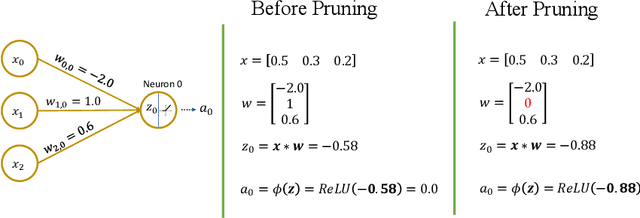
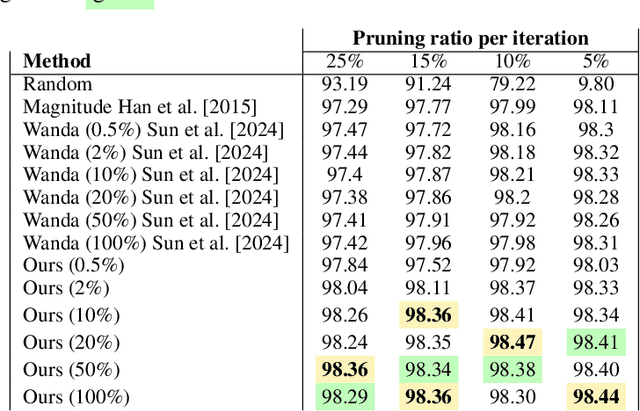
Abstract:Recent advancements have scaled neural networks to unprecedented sizes, achieving remarkable performance across a wide range of tasks. However, deploying these large-scale models on resource-constrained devices poses significant challenges due to substantial storage and computational requirements. Neural network pruning has emerged as an effective technique to mitigate these limitations by reducing model size and complexity. In this paper, we introduce an intuitive and interpretable pruning method based on activation statistics, rooted in information theory and statistical analysis. Our approach leverages the statistical properties of neuron activations to identify and remove weights with minimal contributions to neuron outputs. Specifically, we build a distribution of weight contributions across the dataset and utilize its parameters to guide the pruning process. Furthermore, we propose a Pruning-aware Training strategy that incorporates an additional regularization term to enhance the effectiveness of our pruning method. Extensive experiments on multiple datasets and network architectures demonstrate that our method consistently outperforms several baseline and state-of-the-art pruning techniques.
What Do You See? Enhancing Zero-Shot Image Classification with Multimodal Large Language Models
May 24, 2024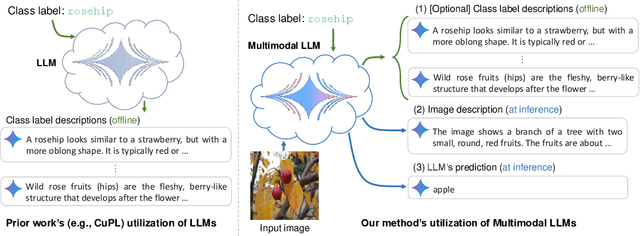
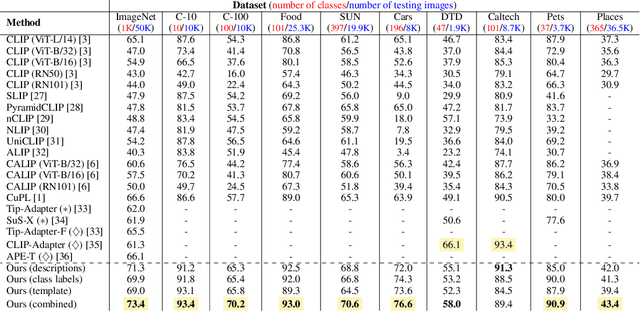
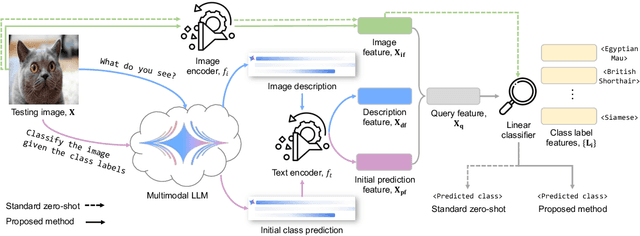

Abstract:Large language models (LLMs) has been effectively used for many computer vision tasks, including image classification. In this paper, we present a simple yet effective approach for zero-shot image classification using multimodal LLMs. By employing multimodal LLMs, we generate comprehensive textual representations from input images. These textual representations are then utilized to generate fixed-dimensional features in a cross-modal embedding space. Subsequently, these features are fused together to perform zero-shot classification using a linear classifier. Our method does not require prompt engineering for each dataset; instead, we use a single, straightforward, set of prompts across all datasets. We evaluated our method on several datasets, and our results demonstrate its remarkable effectiveness, surpassing benchmark accuracy on multiple datasets. On average over ten benchmarks, our method achieved an accuracy gain of 4.1 percentage points, with an increase of 6.8 percentage points on the ImageNet dataset, compared to prior methods. Our findings highlight the potential of multimodal LLMs to enhance computer vision tasks such as zero-shot image classification, offering a significant improvement over traditional methods.
Rawformer: Unpaired Raw-to-Raw Translation for Learnable Camera ISPs
Apr 16, 2024

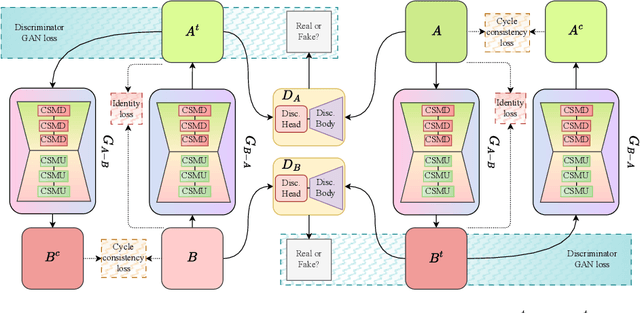

Abstract:Modern smartphone camera quality heavily relies on the image signal processor (ISP) to enhance captured raw images, utilizing carefully designed modules to produce final output images encoded in a standard color space (e.g., sRGB). Neural-based end-to-end learnable ISPs offer promising advancements, potentially replacing traditional ISPs with their ability to adapt without requiring extensive tuning for each new camera model, as is often the case for nearly every module in traditional ISPs. However, the key challenge with the recent learning-based ISPs is the urge to collect large paired datasets for each distinct camera model due to the influence of intrinsic camera characteristics on the formation of input raw images. This paper tackles this challenge by introducing a novel method for unpaired learning of raw-to-raw translation across diverse cameras. Specifically, we propose Rawformer, an unsupervised Transformer-based encoder-decoder method for raw-to-raw translation. It accurately maps raw images captured by a certain camera to the target camera, facilitating the generalization of learnable ISPs to new unseen cameras. Our method demonstrates superior performance on real camera datasets, achieving higher accuracy compared to previous state-of-the-art techniques, and preserving a more robust correlation between the original and translated raw images.
Optimizing Illuminant Estimation in Dual-Exposure HDR Imaging
Mar 04, 2024
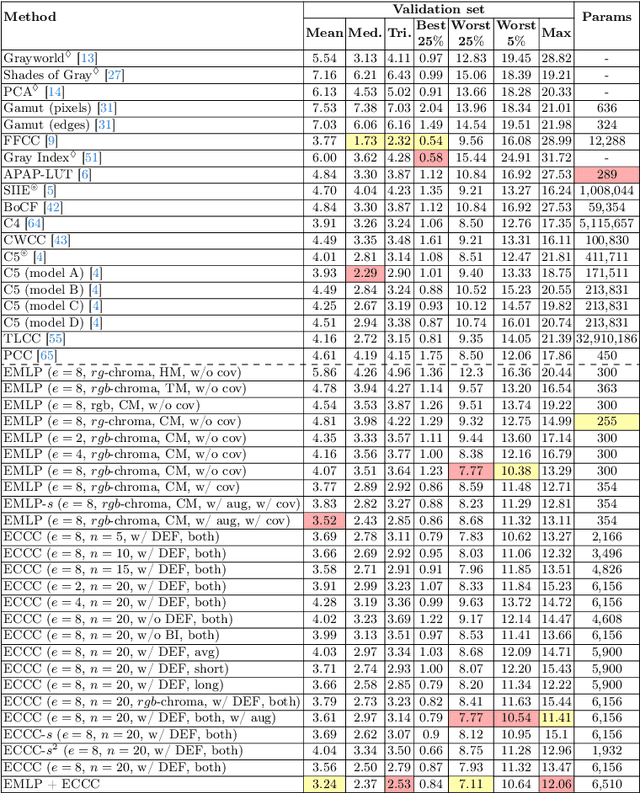
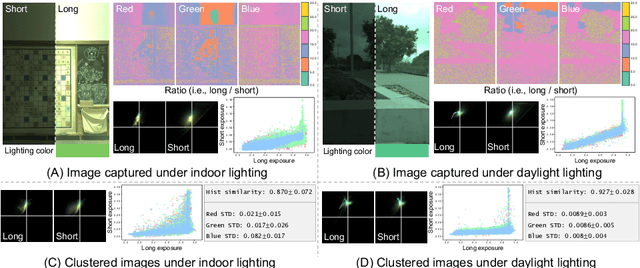
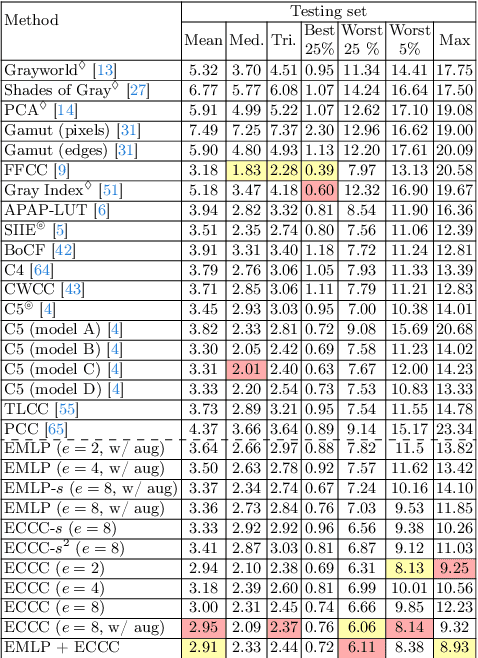
Abstract:High dynamic range (HDR) imaging involves capturing a series of frames of the same scene, each with different exposure settings, to broaden the dynamic range of light. This can be achieved through burst capturing or using staggered HDR sensors that capture long and short exposures simultaneously in the camera image signal processor (ISP). Within camera ISP pipeline, illuminant estimation is a crucial step aiming to estimate the color of the global illuminant in the scene. This estimation is used in camera ISP white-balance module to remove undesirable color cast in the final image. Despite the multiple frames captured in the HDR pipeline, conventional illuminant estimation methods often rely only on a single frame of the scene. In this paper, we explore leveraging information from frames captured with different exposure times. Specifically, we introduce a simple feature extracted from dual-exposure images to guide illuminant estimators, referred to as the dual-exposure feature (DEF). To validate the efficiency of DEF, we employed two illuminant estimators using the proposed DEF: 1) a multilayer perceptron network (MLP), referred to as exposure-based MLP (EMLP), and 2) a modified version of the convolutional color constancy (CCC) to integrate our DEF, that we call ECCC. Both EMLP and ECCC achieve promising results, in some cases surpassing prior methods that require hundreds of thousands or millions of parameters, with only a few hundred parameters for EMLP and a few thousand parameters for ECCC.
Multi-View Motion Synthesis via Applying Rotated Dual-Pixel Blur Kernels
Nov 15, 2021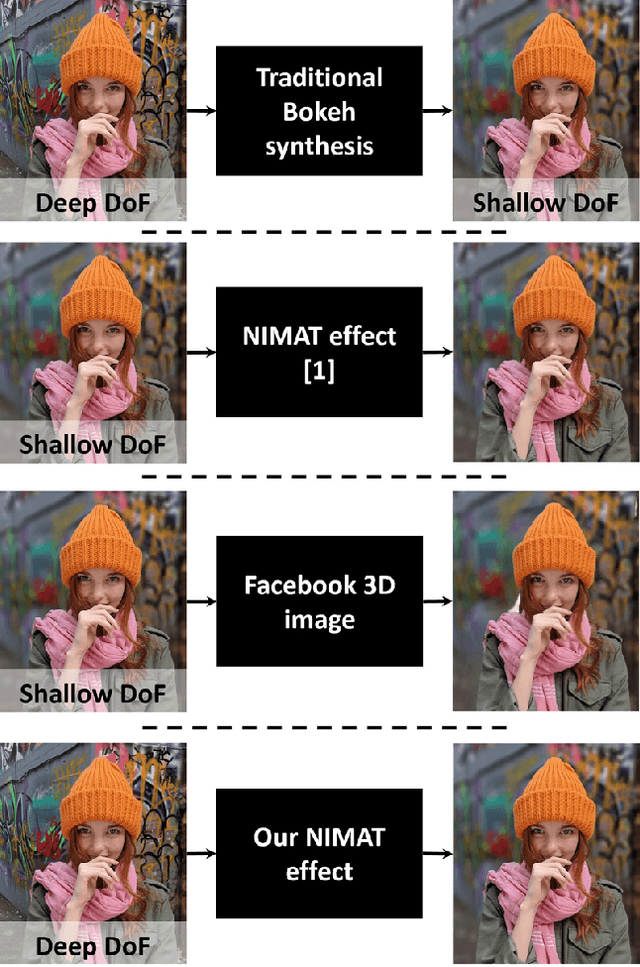



Abstract:Portrait mode is widely available on smartphone cameras to provide an enhanced photographic experience. One of the primary effects applied to images captured in portrait mode is a synthetic shallow depth of field (DoF). The synthetic DoF (or bokeh effect) selectively blurs regions in the image to emulate the effect of using a large lens with a wide aperture. In addition, many applications now incorporate a new image motion attribute (NIMAT) to emulate background motion, where the motion is correlated with estimated depth at each pixel. In this work, we follow the trend of rendering the NIMAT effect by introducing a modification on the blur synthesis procedure in portrait mode. In particular, our modification enables a high-quality synthesis of multi-view bokeh from a single image by applying rotated blurring kernels. Given the synthesized multiple views, we can generate aesthetically realistic image motion similar to the NIMAT effect. We validate our approach qualitatively compared to the original NIMAT effect and other similar image motions, like Facebook 3D image. Our image motion demonstrates a smooth image view transition with fewer artifacts around the object boundary.
 Add to Chrome
Add to Chrome Add to Firefox
Add to Firefox Add to Edge
Add to Edge